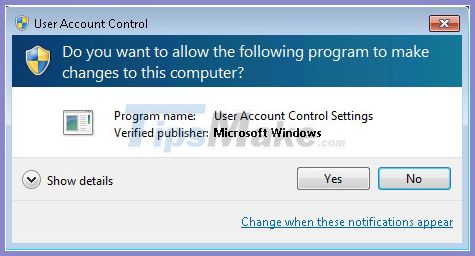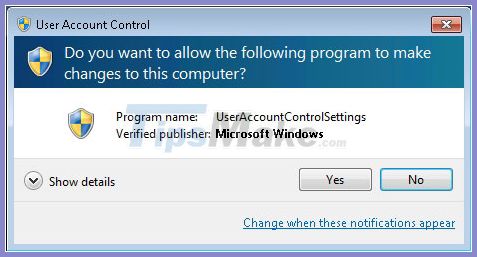What is UAC? How to enable / disable UAC on Windows 10, 8, 7
Every time you download a new application and access it, the User Account Control (UAC) window appears not only once, but even many times while manipulating the application. If this makes you uncomfortable, in this article I will guide you to turn off UAC on Windows 10, 8 and 7.
Besides, I will explain what UAC is and whether to disable it or not, share many different methods to enable / disable it in your Windows computer.
I. What is UAC? Should I turn off UAC?
User Account Control or UAC is part of the Windows security system that prevents an application from making unwanted changes on the PC without your permission. When some software tries to make changes to Windows system and Registry related parts, Windows 10 will display a "UAC confirmation dialog" so that the user will confirm if they really want to make those changes. or not.
UAC therefore provides a special secure environment for your User account, restricting access to generation changes from the application. So the answer to the question of whether to turn off UAC or not is of course "should not be turned off" because it is meant to protect you.
However many users are dissatisfied with seeing these UAC prompts and prefer to use Windows 10 with the classic security model, i.e. by creating a limited and admin account like in Windows XP and earlier. If you're one of those users, here's how to enable and disable UAC and get rid of its pop-ups in Windows.
II. How to enable and disable UAC on Windows 10 and 8.1, 8

The operating systems from Windows 8 and above have quite similar design, you can apply the methods in this section to enable / disable UAC on your Windows 8, 8.1, 10 computer.
Option 1: Turn on and off UAC through Control Panel
To disable UAC using the option in Control Panel, you need to do the following steps:
Step 1: Open the search dialog box by pressing the key combination Windows + Qand then type: UAC
Step 2: Select Change user control settings in the search box.
Step 3: The User Account Control Settings window immediately appears, as in the example below I am setting the alert mode to " Always notify" , ie always alert when the application makes system changes.
Step 4 : Change this status bar to adjust UAC , from always notify (Always notify) -> Never notify (Never notify).
Adjust UAC alert levels to suit your needs, and then click OK to apply the settings.
Method 2: Turn UAC on and off with a simple Registry editing method
If you are having problems with the search box on Windows 10, another way to disable UAC is to use Registry Editor.
Step 1: Press the key combination Windows + Rand then type: regedit
Then click OK to open the Registry Editor.
Step 2: Navigate to the key in the following navigation, you can highlight and copy this path and paste it in the address bar of Registry Editor.
ComputerHKEY_LOCAL_MACHINESOFTWAREMicrosoftWindowsCurrentVersionPoliciesSystem
Step 3: Find the EnableLUA key and double-click on it.
If you do not see it, you can quickly create the key by: Right-clicking on any empty area and then selecting New -> DWORD (32bit) Value then named EnableLUA.
Step 4: At Edit DWORD (32bit) Value window , edit the corresponding value as follows in Value data:
- "1": Enable UAC (Enable)
- "0": Disable UAC (Disable)
Assuming you've entered the picture below Value data = 1, so will trigger UAC . Please enter the value corresponding to your desire, then restart your computer to see the effect.
Method 3: Use the Winaero Tweaker application to turn on and off UAC
You can use the tool to turn on and off Winaero Tweaker simply UAC.
Step 1: Click on User Accounts .
Step 2: Select 1 of the two options:
- Enable UAC: Enable UAC
- Disable UAC: Disable UAC
After you click one of the two options above, the application will automatically turn on / off UAC immediately, the advantage of this option is to help you avoid having to edit the Registry.
Download Winaero Tweaker here
III. How to enable and disable UAC on Windows 7

Step 1: Click the Start Menu and then select Control Panel.
Window in the Control Panel , go to the regime of view by: Small icons then click User Accounts.
Step 2: The screen to make changes to your user account appears, click Change User Account Control settings.

Step 3 : Click Yes.

Step 4: Change UAC alert level to suit my needs, in the picture below I am leaving the alarm level at the highest level (Always notify).
You can reduce the alert level to the lowest level to disable it permanently (Never notify).
Finally click OK to apply settings.

Step 5: Click Yes when asked to apply the setting.

IV. summary
Through the article " What is UAC? Instructions on how to turn on and off UAC on Windows 10,8,7" , you probably already know the use of this feature and how to enable / disable it. Personally, I always turn on UAC but do not set it to too high a warning level, I also advise you to turn it on to ensure the security of the computer.
You should read it
- How to enable or disable Windows features on Windows 10
- Instructions to enable / disable Windows Firewall with Command Prompt
- How to turn Hibernate hibernation on Windows 10
- How to Enable Incognito Mode
- How to enable or disable Secure Sign-In on Windows 10
- How to properly turn off the Raspberry Pi
- How to Enable YouTube Comments
- Open the Excel file and show Enable Editing and something you don't know
May be interested
- Disable / Enable the 'Welcome' screen of Windows XP
 what if you want to change the login way of your computer, can you disable or enable welcome screen?
what if you want to change the login way of your computer, can you disable or enable welcome screen? - How to enable and disable the standby screen mode in Windows 10
 how to enable and disable the standby screen mode in windows 10. the screen saver (screen saver) is a feature that helps your computer operate with lower power but still ensures the computer turns on quickly when you return. work. this feature is extremely useful when we use the old crt monitors with a long boot time.
how to enable and disable the standby screen mode in windows 10. the screen saver (screen saver) is a feature that helps your computer operate with lower power but still ensures the computer turns on quickly when you return. work. this feature is extremely useful when we use the old crt monitors with a long boot time. - How to enable, disable REFS format on Windows 10
 whether to enable or disable refs formatting in windows 10 is still a controversial issue. is refs really necessary for you? if not, you can consider disabling this feature to improve system performance.
whether to enable or disable refs formatting in windows 10 is still a controversial issue. is refs really necessary for you? if not, you can consider disabling this feature to improve system performance. - How to enable or disable Secure Sign-In on Windows 10
 windows is the operating system most targeted by hackers. therefore, you should reinforce your pc's defense system to keep it safe, even online and offline. this article will show you how to enable or disable secure sign-in on windows 10.
windows is the operating system most targeted by hackers. therefore, you should reinforce your pc's defense system to keep it safe, even online and offline. this article will show you how to enable or disable secure sign-in on windows 10. - How to enable and disable Micro on Windows 10
 how to turn on and off the microphone on windows 10. in today's technology era, computer users are very vulnerable to personal data mining through the computer's microphone. because of that, we need to strictly control the output sources of the micro to protect ourselves from the prying eyes of the bad guys.
how to turn on and off the microphone on windows 10. in today's technology era, computer users are very vulnerable to personal data mining through the computer's microphone. because of that, we need to strictly control the output sources of the micro to protect ourselves from the prying eyes of the bad guys. - How to enable / disable video input in Windows Sandbox on Windows 10
 windows sandbox provides a lightweight desktop environment to safely run applications. this tutorial will show you how to enable or disable video input in windows sandbox for all users in windows 10.
windows sandbox provides a lightweight desktop environment to safely run applications. this tutorial will show you how to enable or disable video input in windows sandbox for all users in windows 10. - 2 ways to enable / disable clipboard sync on Windows 10
 by default, clipboard sync is turned off. in this tutorial, tipsmake will show you 2 methods to enable or disable clipboard sync feature on windows 10.
by default, clipboard sync is turned off. in this tutorial, tipsmake will show you 2 methods to enable or disable clipboard sync feature on windows 10. - How to enable or disable NTFS file encryption in Windows
 this article will show you how to enable or disable ntfs file encryption for all users in windows 7, windows 8 and windows 10.
this article will show you how to enable or disable ntfs file encryption for all users in windows 7, windows 8 and windows 10. - Enable / disable JavaScript on Chrome browser
 knowing how to enable / disable javascript will help you take the initiative when working on the browser. let's follow how to turn off and turn on javascript on chrome below, also quite simple.
knowing how to enable / disable javascript will help you take the initiative when working on the browser. let's follow how to turn off and turn on javascript on chrome below, also quite simple. - What is Windows Defender? What are the advantages? How to enable and disable Windows Defender
 provides information about windows defender advantages, features as well as how to enable and disable windows defender. click for more details!
provides information about windows defender advantages, features as well as how to enable and disable windows defender. click for more details!










 How to disable Windows key on PC
How to disable Windows key on PC How to open virtual keyboard on Win XP / 7/8 / 10
How to open virtual keyboard on Win XP / 7/8 / 10 How to re-enable Registry backup on Windows 10
How to re-enable Registry backup on Windows 10 How to download and use the Program Install and Uninstall Troubleshooter in Windows
How to download and use the Program Install and Uninstall Troubleshooter in Windows How to view photos as a slide show on Windows 10
How to view photos as a slide show on Windows 10 What is ApMsgFwd.exe?
What is ApMsgFwd.exe?